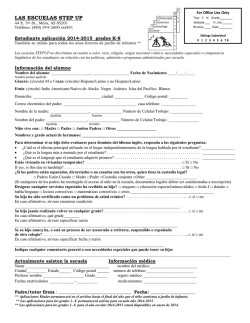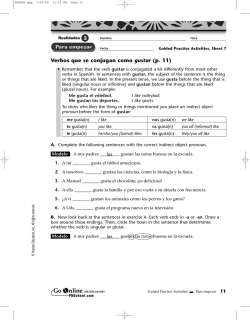
El verbo doler
Español II EL VERBO DOLER Doler works like the verb gustar. Conjugating gustar: Step 1 Figure out what is being liked. If the thing being liked is singular or a verb, use gusta. If the thing being liked is plural, use gustan. Conjugating gustar: Step 2 Figure out who is doing the liking. Conjugating gustar: Step 2 If the subject is… Use… I A mí me you A ti te A Ud. le he A él le she A ella le You guys You girls A nosotros nos A ____ y a mí nos A ti y a mí nos A vosotros os A vosotras os You’all A Uds. les They A ellos les A ellas les A _____ y a _____ les we Conjugating gustar: Step 3 Put steps one and steps two together with the thing being liked. [step two answer] + [step one answer] + [thing being liked] Ejemplos A mí _____ _____________ el español. A mí me gusta el español. Ejemplos ___ _______________ nos gustan ____________________________. (videogames) A nosotros nos gustan los videojuegos. Ejemplos ___ Luisa y ____ Juan __________ _______________ dormir en la clase de español. A Luisa y a Juan les gusta dormir en la clase de español. El verbo doler ¿Qué significa? to hurt, to ache Conjugating doler: Step 1 Figure out what is hurting or aching. If it is a single body part, use duele. If it is a plural body part, use duelen. Conjugating doler: Step 1 Be careful: Even plural subjects could still have only a single body part hurting. A. Nos duele el dedo. B. Nos duelen los dedos. C. Les duele el codo. D. Les duelen los codos. Conjugating doler: Step 2 Figure out who is being hurt or aching. Conjugating doler: Step 2 If the subject is… Use… I A mí me you A ti te A Ud. le he A él le she A ella le You guys You girls A nosotros nos A ____ y a mí nos A ti y a mí nos A vosotros os A vosotras os You’all A Uds. les They A ellos les A ellas les A _____ y a _____ les we Conjugating doler: Step 3 Put steps one and steps two together with the body part that hurts or aches. [step two answer] + [step one answer] + [body part] In English we use a possessive adjective (my, your, his, our, their) to talk about body parts. In Spanish, they just use the definite article (el, la, los, or las). Ejemplos A mí me duele _________________. A mí me duele la mano. Ejemplos A Luisa _____ duele la cabeza. A Luisa le duele la cabeza. Ejemplos ______________________ nos duele el pie. A nosotros nos duele el pie. Ejemplos _______________ y ____________ les duelen las piernas. A Juan y a Guadalupe les duelen las piernas.
© Copyright 2025





